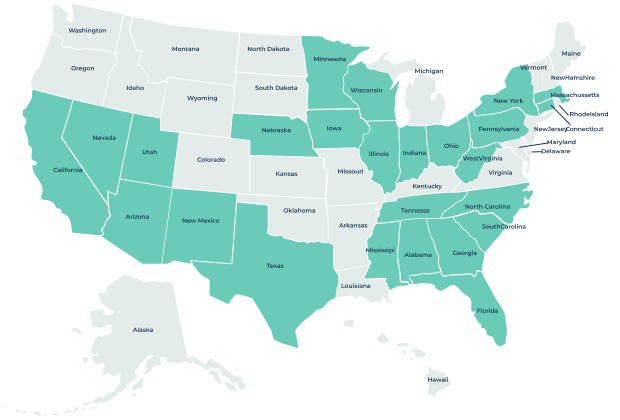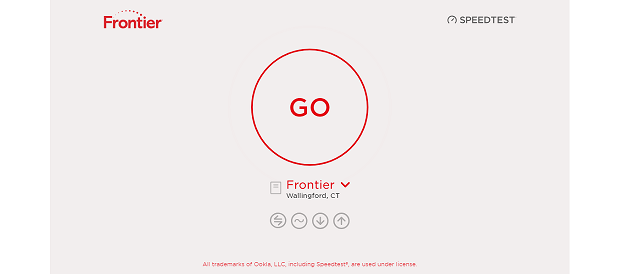Wi-Fi Site Surveys, Analysis, Troubleshooting runs on a MacBook (macOS 11+) or any laptop (Windows 7/8/10/11) with a standard 802.11be/ax/ac/n/g/a/b wireless network adapter. Read more about the 802.11be support here.
Frontier Internet Review
Frontier Communications is an American telecommunications company with a long history. It was founded in 1935, and it has since then expanded its operations across a number of rural areas and metropolitan markets alike.
Frontier operates a Digital Subscriber Line (DSL) internet network, and it also offers fiber services (formerly known as Frontier FiOS internet). The former option relies on twisted copper phone lines, while fiber internet connections use dedicated fiber optic cables. But is Frontier home internet and Frontier business internet any good? That's what this review is here to help you find out.
Frontier Internet Plans and Pricing
Let's start by taking a quick look at Frontier fiber optic internet plans:
| Plan | Maximum speeds | Limit | Promo rate |
| Frontier Fiber Internet 500/500 | 500 Mbps download, 500 Mbps upload | Unlimited | $49.99 a month |
| Frontier Fiber Gig | 940 Mbps, 880 Mbps upload | Unlimited | $74.99 a month |
| Frontier Fiber 2 Gig | 2,000 Mbps download, 2,000 Mbps upload | Unlimited | $149.99 a month |
We can now compare Frontier FiOS internet plans with Frontier high-speed internet plans that rely on twisted copper phone lines:
| Plan | Maximum speeds | Limit | Promo rate |
| Frontier Basic Internet | 9 Mbps download, 1 Mbps upload | Unlimited | $33 a month |
| Frontier Preferred Internet | 25 Mbps, 1 Mbps upload | Unlimited | $40 a month |
| Frontier Premium Internet | 115 Mbps download, 3 Mbps upload | Unlimited | $50 a month |
The first thing you will likely notice when you look at the two tables above is the vast difference in Frontier internet speeds fiber optic and DSL users get.
While the basic Frontier fiber internet plan provides download and upload speeds of up to 500 Mbps for $49.99 a month, the least expensive DLS plan is actually just $17 cheaper, but it comes with the maximum download and upload speeds of just 9 Mbps and 1 Mbps, respectively.
This pattern continues as you move up to more expensive Frontier internet plans. The Frontier Fiber 2 Gig plan costs $149.99 a month and includes 2000 Mbps download and 2000 Mbps upload speeds, whereas the Frontier Premium Internet DSL plan costs $50 a month and includes 115 Mbps download and 3 Mbps upload speeds.
The good news is that all Frontier fiber optic and DSL plans are completely unlimited, so you can download and upload as much data as you want without ever having to worry about Frontier throttling your speeds to a crawl.
Like most other internet service providers, the prices Frontier advertises are discounted to attract new customers, and they don't last forever. After the first 12 months, you can expect to pay around $10 more, but the exact sum can vary by region, so you better read your contract carefully to avoid unpleasant surprises.
In general, Frontier internet prices are reasonable, but the differences between Frontier internet fiber optic and DSL speeds are huge, so you really need to carefully evaluate your needs and choose accordingly.
As a rule of thumb, we recommend you avoid the basic DSL plan, called Frontier Basic Internet. Offering just 9 Mbps download and 1 Mbps upload speeds, this plan is barely usable even if your needs are truly modest. For just $7 more, you can get the Frontier Preferred Internet plan, which is good enough even for light streaming and video conferencing.
Frontier Internet Coverage
Frontier internet plans are available in the following regions:
| Alabama | Nevada |
| Arizona | New Mexico |
| California | New York |
| Connecticut | North Carolina |
| Florida | Ohio |
| Georgia | Pennsylvania |
| Illinois | South Carolina |
| Indiana | Tennessee |
| Iowa | Texas |
| Massachusetts | Utah |
| Minnesota | West Virginia |
| Mississippi | Wisconsin |
| Nebraska |
As you can see, Frontier internet coverage includes most of the Southeast, Northeast, Midwest regions, and West Coast regions.

Frontier's fiber optic service is available predominantly in metropolitan markets, so customers in rural areas are often left with Frontier DSL plans.
While Frontier internet availability is pretty good thanks to the broad coverage provided by the combination of fiber optic and DSL internet, the same can't be said about its reliability.
DSL customers in particular complain about frequent connection drops that often last for hours. Downdetector.com confirms that their complaints are well founded. In fact the Federal Trade Commission and six states are suing Frontier, alleging that the company doesn't provide its consumers with internet service at promised speeds.
Fortunately, the fiber optic service is much better when it comes to reliability, and even remote employees who depend on a stable internet connection should have no issues with it.
Frontier Internet Fees & Bonuses
We've already explained that Frontier gives new customers lower introductory prices to lure them in. The good news is that there's no too many other potentially surprising expenses that you should be aware of.
Frontier charges new customers a one-time activation fee of $85, but avoiding this fee is quite easy thanks to frequent promotions that include a free activation.
Until 2020, Frontier used to charge $10 a month to rent a Frontier internet router, but those who bring their own modem can now avoid this fee thanks to the Television Viewer Protection Act of 2019 (TVPA), which makes it illegal for ISPs to charge customers money for using their own equipment.
If you're willing to pay $6 more every month, you can add the Frontier HomeShield Bundle to your plan to protect smartphones, tablets, and computers from digital threats. The bundle also includes advanced parental controls that make it easy to safeguard children while they surf the internet.
We recommend you skip the Frontier HomeShield Bundle and use the money to buy a Wi-Fi analyzer app like NetSpot.

With NetSpot, you can quickly and easily check the security settings of your wireless network (Open, WEP, WPA/WPA2 Personal/Enterprise), and you can also troubleshoot issues that commonly lead to sub-par internet speeds, such as wireless interference and poor router placement.
Whenever you use NetSpot to optimize your Frontier WiFi configuration, you should perform a Frontier internet speed test to verify if the changes you've made have actually improved your online experience.

Frontier Customer Service & Satisfaction
You can get in touch with Frontier's customer service by:
- Dialing 1-800-921-8101
- Visiting your local Frontier store
- Using the online chat feature
- Scheduling a call back
- Sending a direct message on X
- Messaging the company on Facebook
The American Customer Satisfaction Index gives Frontier internet customer service the second worst score (57/100), with only Suddenlink being slightly worse (55/100).
Other customer satisfaction reports, as well as independent Frontier internet reviews, paint the same bleak picture. For example, J.D. Power ranked Frontier's customer support as the worst in three out of four regions, and the Better Business Bureau (BBB) currently registers over 5,700 customer complains.Here's what some Frontier customers have to say about the provider on the BBB website, where it has a rating of 1 out of 5 stars:
Summary
Frontier is a polarizing internet service provider. On the one hand, all Frontier internet plans are unlimited, reasonably priced, and available in many rural and metropolitan regions alike. On the other hand, the provider's DSL plans are plagued with reliability issues, and its customer support service is among the worst in the industry.
As such, we recommend Frontier DSL and fiber optic plans (there are no dedicated Frontier WiFi plans) only to those who live in areas where better-rated internet service providers don't operate.
FAQ
With the Frontier Fiber 2 Gig fiber optic plan, you can enjoy download and upload speeds of up to 2,000 Mbps, which is so fast that you would have to try very hard to max out your internet connection.
Frontier offers both DSL and fiber optic plans. The former type of internet connection relies on twisted copper phone lines, while fiber internet connections use dedicated fiber optic cables.
No, Frontier isn't owned by Verizon, but the internet service provider acquired some Verizon Communications' landline assets in 2009.
Yes, Frontier FiberOptic used to be called Frontier FiOS or FiOS from Frontier.
